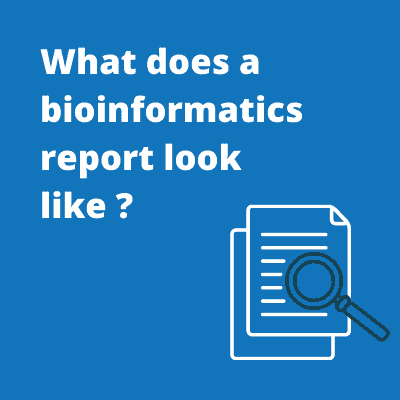Bioinformatics Report Example – Your Data Explained
- 19th October 2021
- Posted by: Breige McBride
- Category: Bioinformatics

Wondering what a bioinformatics report looks like? At Fios Genomics, we have designed our bioinformatics data analysis reports with our clients in mind. Therefore, our reports will not confuse you by showing more data – for data’s sake; instead, they provide relevant information in an organised way that will help you to draw conclusions.
Of course, that does not mean that our reports lack information. In fact, our bioinformatics reports contain a wealth of results, presented interactively so that you are able to explore your data fully. Alongside the results, our reports also try to draw meaningful insights and interpretations that are written by the analyst and reviewed by our editorial team.
We can do this because we do not just understand data, we understand the biology behind them.
The majority of Fios bioinformaticians completed their first degree in biology or a related discipline before gaining further qualifications in bioinformatics. This means that not only can we grasp your research goals and understand your question; we can also recognise and interpret the biologically relevant results generated by the analyses we perform.
So, what does that look like exactly?
What Our Bioinformatics Reports Look Like
All Fios Genomics reports are presented as a secure webpage with multiple pages logically separating out stages of our analysis. Typically this webpage has the following structure:
- Executive Summary: this provides an overview of the results obtained and is handwritten by our analyst to provide an overview of the analysis performed, the take-home message, as well as any possible limitations or recommendations for future work.
- QC/EDA: Typically, we designate a full page to assessing the quality of the data and performing exploratory data analysis to ensure the statistical approaches applied are well justified and sound.
- Results: In the majority of reports, we will include one or more sections devoted to analyses designed to answer your biological question. We will provide interpretation alongside all of the results generated.
- Supplementary: Where relevant we include a supplementary section to provide a methods section for details of analyses performed, references and a list of all software and versions used.
As an illustration of what this looks like, the video below shows a walkthrough of one of our sample bioinformatics reports:
Fully Explore Your Data
As illustrated below, Fios data analysis reports attempt to be as interactive as possible, allowing you to delve deeper into your data.

What Fios Clients Think Of Our Bioinformatics Reports
Below is a short overview of some client feedback about our bioinformatics reports. To read more client testimonials then please visit our Clients and Partners page.
Fios provide you with a very nice data package, that is fully interpretable and allows to draw meaningful conclusions.
Dr. David Moffat, Director of Chemistry at Macrophage Pharma
The data package was Web-based and interactive and we were delighted with the way it was presented and explained to us. We will certainly work again with the Fios team for any future projects.
Dr Nigel Brooks, Director of Translational Science at CellCentric
The biology insight our client gained thanks to their interactive analysis reports really added value to the data.
Dr Keith Bowers, Senior Business Development Manager at OracleBio
Request a sample bioinformatics report
At Fios Genomics, we avoid providing clients with lists or more data. Instead, our analysis solutions provide relevant, reliable and actionable information. Our conclusions are data-driven and led by biology rather than statistics, as you can see in our data analysis report examples.
Complete the form below to receive the report.
Author: Breige McBride, Content and Social Media Manager, Fios Genomics
Reviewed by Fios Genomics Bioinformatics Experts to ensure accuracy
More from Fios Genomics:
Leave a Reply
You must be logged in to post a comment.

